What does it mean to be a Native American tribe? In Ohio, the answer is complicated
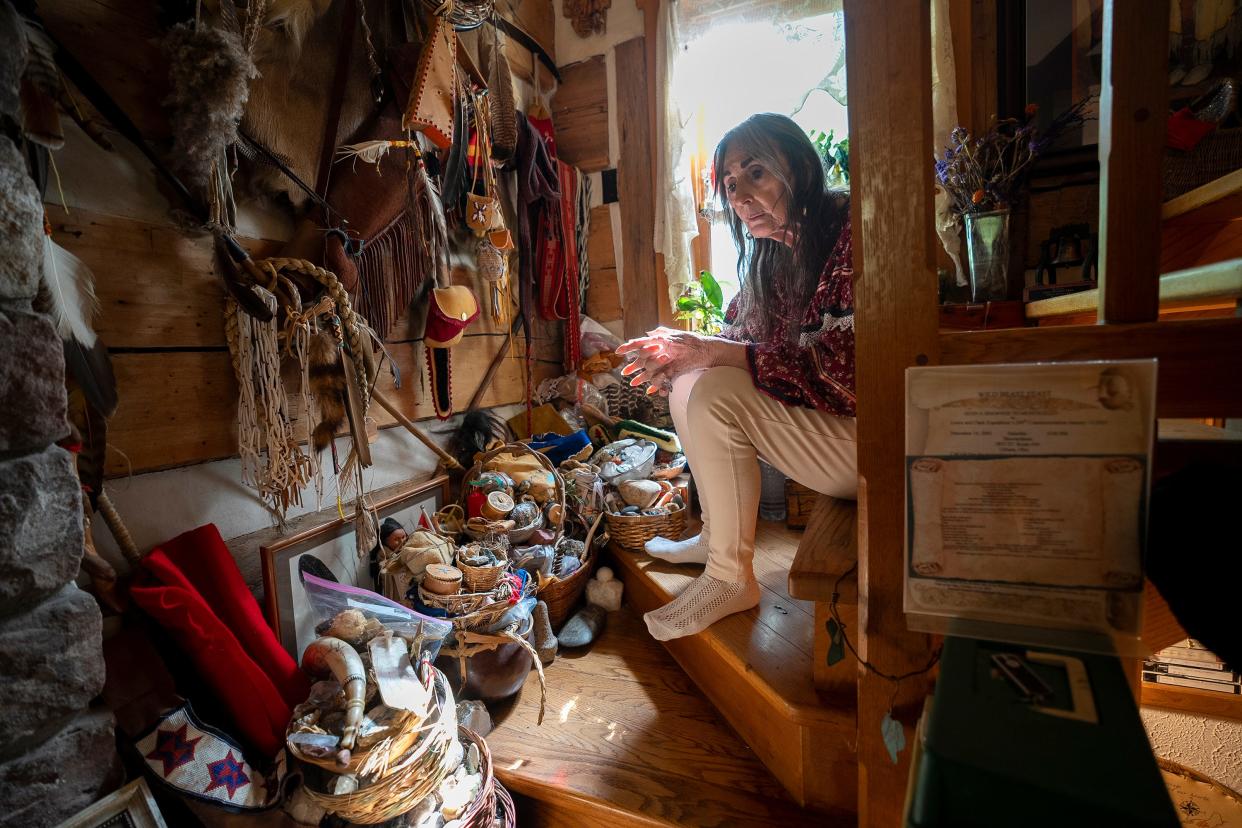
- Oops!Something went wrong.Please try again later.
In the rolling hills of Bloomington, Indiana, lives a woman who has spent her 81 years collecting artifacts and artwork about the people from whom her grandparents told her she came.
Dark Rain Thom identifies as a descendant of the Shawnee, a group of Native Americans that were largely forced to relocate from Ohio to Oklahoma nearly two centuries ago. Thom has represented the Shawnee in national speaking engagements, was honored with an award by at least one of three Shawnee tribes, and she researched and wrote books about the group's history in her native Ohio.
But the tribe of Shawnee that Thom belongs to has never been recognized by her own people or the U.S. government. Thom sees it as a slight that could have serious implications as the National Congress of American Indians (NCAI) is to vote this fall on whether to limit the power of tribes like Thom’s.
For Thom — a former clan mother of the Bellefontaine-based United Remnant Band of Shawnee — the move can be boiled down to one word: “stupid.”
“I’m not hurt, I’m mad,” Thom said about the possible changes at NCAI. “I have good feelings about most Indians. … But my experience with some was: ‘You're not tribal, you’re bull----. That's not true and it's not nice.”
While Thom sees the move as an affront, the leaders of some federally recognized tribes disagree.
If the proposed changes at NCAI are approved later this year, it will mean that non-federally recognized tribes will lose voting power for the first time in the governing body’s 80-year history. The changes would still allow potentially hundreds of non-federally recognized tribes to remain “associate members” of NCAI, said Ben Barnes, chief of the Shawnee Tribe in Oklahoma , and one of a few leaders proposing the constitutional amendments for NCAI.

The change, Barnes said, is needed because self-declared tribes and state-recognized ones have sown confusion among the public and blurred the line between legitimate Native American tribes and social clubs or nonprofit groups.
In fact, Barnes said state recognition is sometimes a disservice to the Native American community by providing an aura of legitimacy to groups that don’t always deserve it.
“I don't even like the term (state-recognized) because they're not,” Barnes said. “They are a collage. They are a collage of individuals misrepresenting themselves as a tribal nation because a nation is something wholly, distinctly different.”
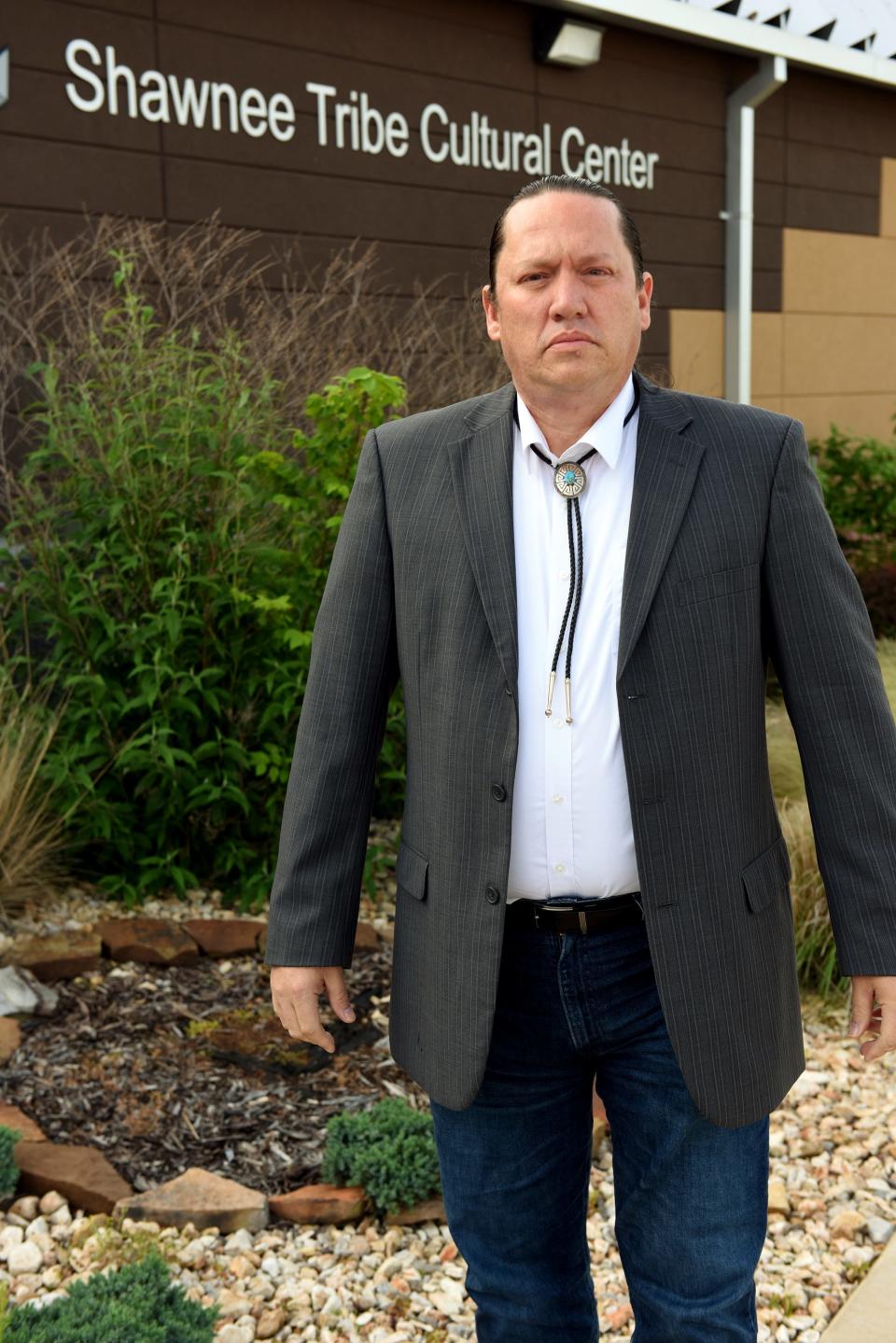
‘Because we are asking for it’
Although Thom now calls an Indiana cabin her home, she spent much of her life in southern Ohio. She became active in the United Remnant Band (URB) in the 1970s, and said she helped push for state recognition.
Starting in 1979, Ohio’s legislature began hearings on HJR-8, a resolution written to provide recognition to the group.
The hearings stretched into 1980, with legislators asking questions about bloodlines and why they should provide some form of designation to the United Remnant Band.
Partial state records obtained by The Dispatch show that members of the URB testified before the legislature, although Thom doesn’t appear to have been one of them.
A witness by the name of Tukemas told legislators that the band had about 200 members and met four times annually. When one lawmaker asked why the state should recognize the tribe, Tukemas responded simply: “Because we are asking for it.”
The legislature passed a resolution in 1980 recognizing the URB.
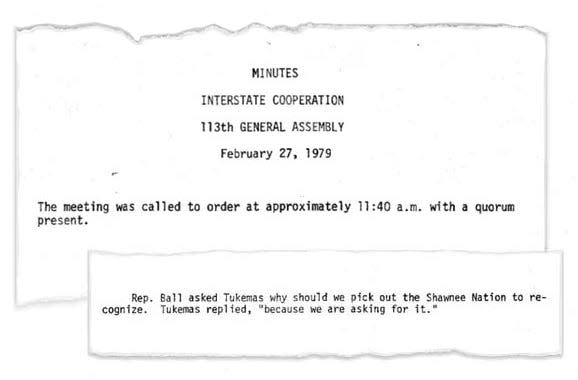
The band never achieved federal recognition, though in 1996, after forming a nonprofit group, the URB raised money and purchased a cave system in Bellefontaine and named it the Zane Shawnee Caverns, according to the Ohio History Connection. The group also established a campground at Southwind Park, which is part of the cavern property.
Leaders of the nonprofit group, which still owns the caverns and campgrounds, did not return repeated calls and emails seeking comment.
The URB was at one time one of more than 400 non-federally recognized tribes nationwide, according to a Government Accountability Office (GAO) report released in 2012, the most recent year for which data is available. It’s unclear how many remain active today.
To become federally recognized, tribes must apply through the Bureau of Indian Affairs or be named one through an act of the United States Congress a presidential executive order, federal administrative action, or through federal court decisions, according to the bureau. Providing proof of a treaty with the U.S. or another country is typically the easiest path to federal recognition.
Nationwide, there are 574 federally recognized tribes, none of which call Ohio home, according to the Bureau of Indian Affairs.
If it weren’t for what seem to be “50 varying degrees” for how groups can be identified as Native American tribes, Barnes said the changes NCAI is considering wouldn’t be necessary. His amendment, he said, will make sure that only fully recognized tribes have a seat at the table for decisions with national impact.
“There has to be some sort of rigor, some sort of history,” Barnes said. “When the story of the tribe lies in fabricated family stories or mythologies or ‘I heard my grandma say,’ that’s not the same as ‘we had a treaty with Spain.’ … Those are very different things.”
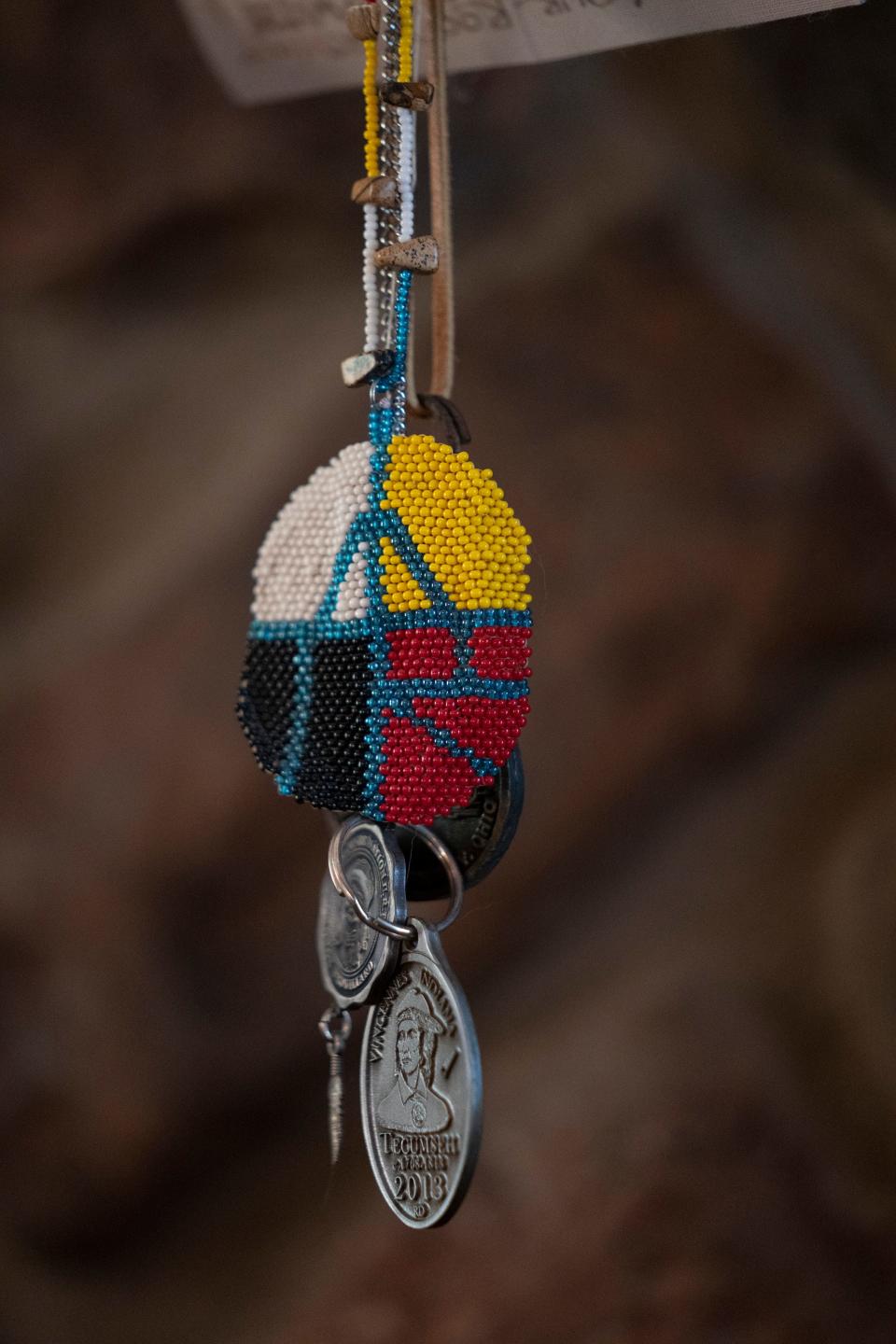
‘Decisions that affect people’s lives’
The discord that sprung from the debate over tribal recognition goes beyond implications of history or cultural appropriation.
Tribes have governments and power. As such, they hold elections, put defendants on trial in courts and make child custody decisions, among other things.
Chiefs are also able to interact with the U.S. government and other countries. Barnes himself has testified before the United Nations as the leader of a sovereign nation.
That kind of power is too massive to offer to any and all groups that insist they are tribes, Barnes said.
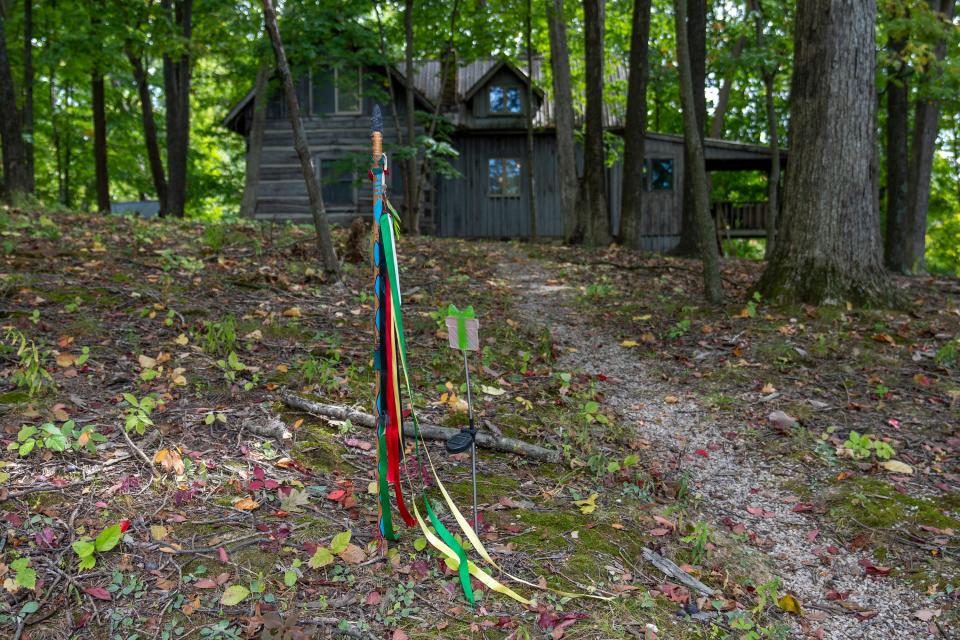
“These are decisions that affect people's lives. We can't be giving out these type of things willy-nilly to self-claimants of identity. And this is not us being racial cops, or making determinations if someone is Indian enough,” he said. “These are real governments … and we have groups masquerading as us.”
On top of the power federally recognized tribes hold, they compete with each other for limited resources.
Some non-federally recognized tribes may seek some form of recognition for the wrong reasons, such as the ability to establish a casino, said Glenna Wallace, chief of the Eastern Shawnee Tribe of Oklahoma. Wallace also fears that tribes without national recognition could be awarded federal funds that would otherwise go to legitimate tribes that need them to serve their people.
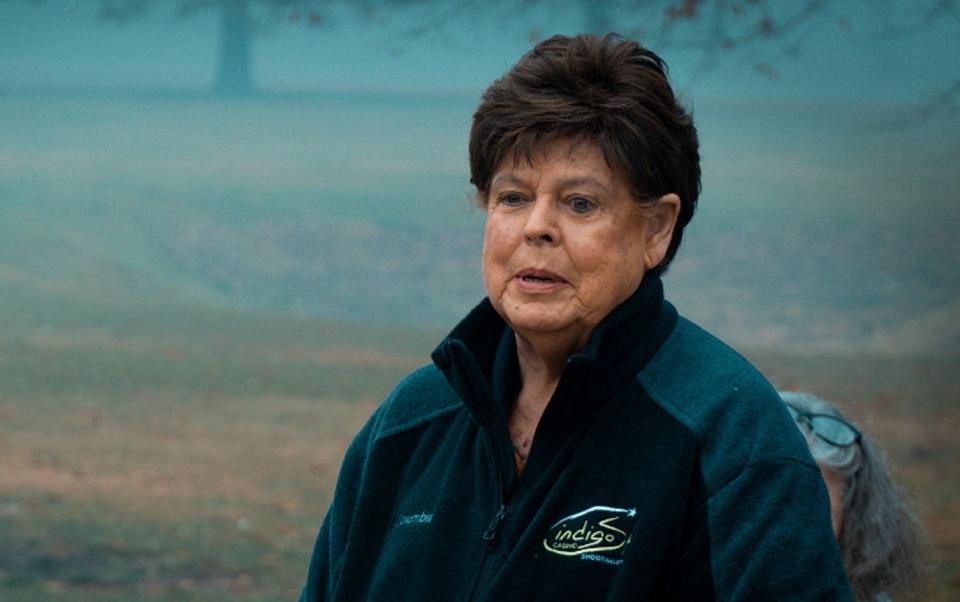
“If they would be eligible for grants and programs, they are in competition with federally recognized tribes who are struggling to survive and struggling to advance,” Wallace said.
A report from the U.S. Government Accountability Office shows Wallace may be right to worry.
From fiscal year 2007 through fiscal year 2010, the GAO found that at least $100 million in federal funding was awarded to tribes without national recognition. Most of the funding was awarded by the U.S. Department of Housing and Urban Development, though some also came from the Department of Health and Human Services and the Department of Education, the GAO found.
“It’s an expense every American taxpayer is paying for,” Barnes said. “They’re taking away housing dollars from every underprivileged community across the United States."
How the process sometimes gets it wrong
Although Barnes considers federal recognition to be the gold standard for tribes, he admitted that the process sometimes makes the wrong decision.
For example, Barnes said the Little Shell Tribe of Chippewa Indians of Montana was denied status by the Bureau of Indian Affairs in 2009 because it was missing evidence that it had been a Native American tribe continuously since 1900; that it had a distinct community and social relationships; and that it kept political influence over its members. It was a denial that many disagreed with, and it caused an uproar until Congress granted the tribe federal recognition in 2019.
“All of us rose up in unison and said: ‘No, you got this one wrong,’” Barnes said of the denial. “‘We know who these people are, and we know they have treaties. Just because they're lacking in this one little, tiny data point doesn't mean they're not a people.’”
It’s rare for tribes to get the federal government’s stamp of approval anymore.
In the last 10 years, just eight have gained federal recognition, seven of which were through acts of Congress, according to the U.S. Bureau of Indian Affairs. Five tribes have pending petitions for recognition before the bureau, and four were denied in that same time period.
Like the Little Shell Tribe of Chippewa, the Michigan-based Pokagon Band of the Potawatomi fought for decades for federal recognition, said John Low, an associate professor who studies Native American history at Ohio State University’s Newark campus. Low himself is a member of the Pokagon Band of the Potawatomi.
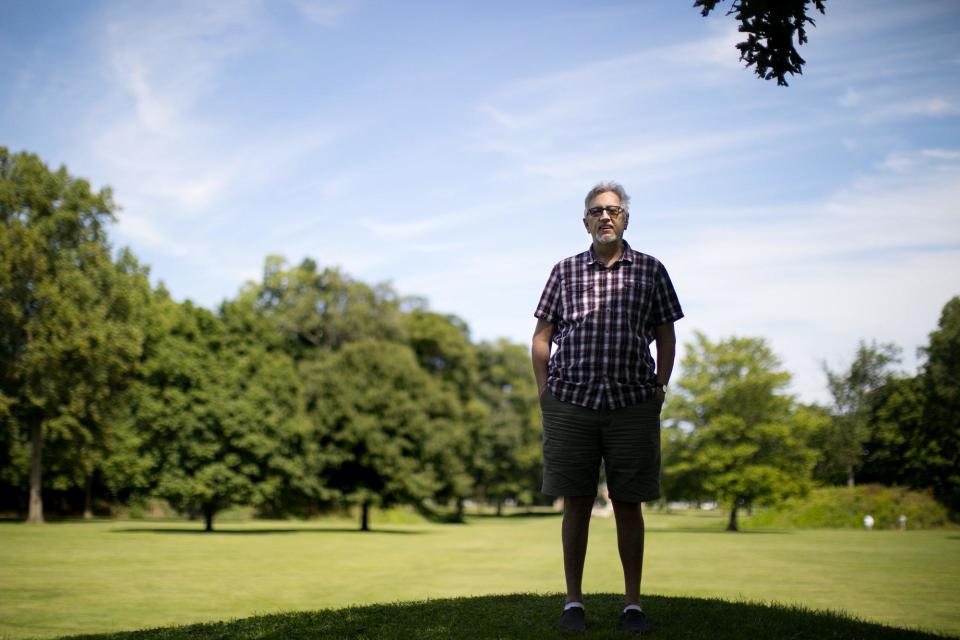
The tribe, Low said, signed a treaty with the federal government in the 1830s.
But during the Great Depression, the federal government passed an act known as the Indian Reorganization Act of 1934, which curtailed lands allotted to tribes. The Potawatomi applied for recognition after the law passed, but were denied by the Bureau of Indian Affairs.
It wasn’t until an act of Congress in 1994 that the Potawatomi finally gained its sovereign status that comes with federal recognition.
And despite his own tribe’s decades-long fight for federal recognition, Low said the process sets a necessary standard to preserve legitimate Native American tribes and heritage.
“It is difficult to meet that approval,” Low said. “It’s not a perfect system, but it’s important that we do keep a boundary between social clubs and hobbyists and re-enactors and legitimate sovereign nations.”
Differentiating between the indigenous and the ‘pretendians’
Tribes that lack federal recognition also raise questions of genealogy and identity.
Some members of self-declared or state-recognized tribes have little to no Native American ancestry, both Barnes and Low said. Several prominent figures who have been outed for claiming false indigenous heritage show Low and Barnes may have good reason for concern.
“It happens so often that it's a joke in Indian country,” Barnes said. “It's so constant that someone has a Cherokee princess grandma, that it's become comic.”
It’s not uncommon for people to claim Native American ancestry when they actually have none, said Jacqueline Keeler, a writer who has extensively researched and studied the topic. They’re known as “pretendians,” said Keeler, who is herself a member of the Navajo Nation.
It’s unclear how pretending to be Native American became popular, Keeler said. It’s likely that some people make up their ancestry for their own benefit, while, for others, it starts off as a family story that never gets fact-checked, Keeler said.
Even U.S. Census data should be looked at with some skepticism, Keeler said, as it shows a dramatic rise in the number of Americans who claim to be indigenous. The number of Americans who identified as being at least partly native grew by around 86% from roughly 5.2 million people in 2010 to 9.7 million in 2020, Census data shows.
Regardless of how or why the number of so-called fakers is growing, Keeler said they’ve popped up in every facet of life. Several prominent figures, including Sen. Elizabeth Warren, D-Massachusetts, and the famed actress and activist Sacheen Littlefeather, have been outed for claiming false indigenous heritage."
Pretending to be Native American, Keeler said, should be considered practicing “red face.”
“They're monetizing our trauma and building their careers on it,” Keeler said.
An honor without recognition
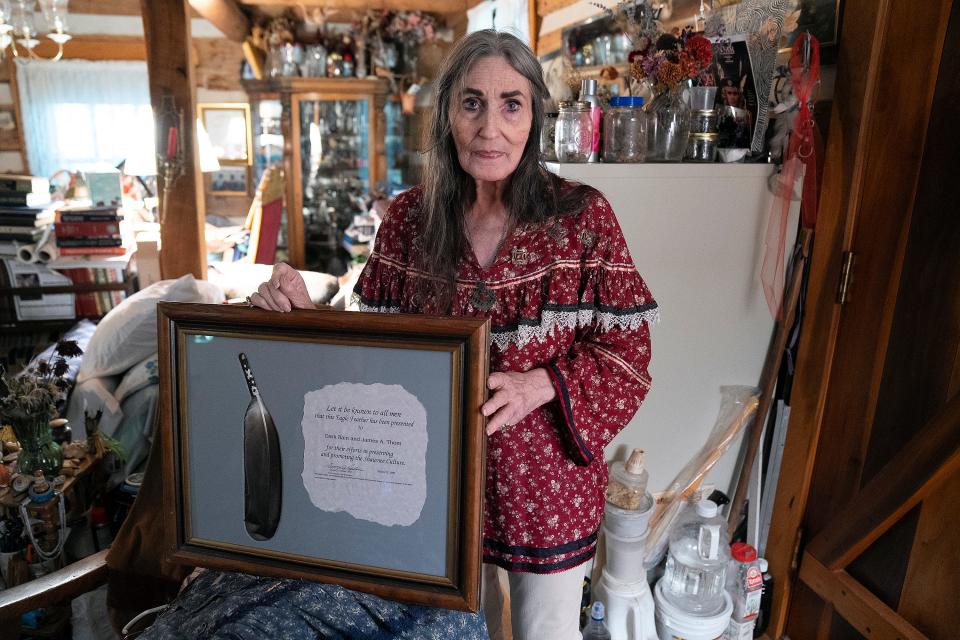
On the wall of Thom’s wooden cabin hangs a framed eagle feather.
Next to the feather is an inscription, dated 1994, that recognizes Thom and her late husband, James, for their efforts in “preserving and promoting the Shawnee Culture.”
The distinction is from then-Chief George “Buck” Captain of the Eastern Shawnee Tribe of Oklahoma.
Yet despite this honor, Thom herself has been questioned about her genealogy. Barnes told The Dispatch he hasn’t seen clear evidence of Thom’s Shawnee ancestry while Keeler, who researches so-called "pretendians," said she hadn't heard of Thom.
Thom has denied such accusations. She now considers herself to be a tribal elder with the East of the River Shawnee, a non-federally recognized group that broke off from the United Remnant Band of Shawnee years ago.
To questions of her heritage, she said she has Native American blood on both sides of her family, from her maternal and paternal grandfathers.
She said she found her family members' names on the Dawes Rolls, which are U.S. government lists of individuals who proved tribal membership in the late 1800s.
“Thank God it’s not based on belief,” she said of her ancestry. “It makes me feel sorry that (some are) so undereducated about telling who is an Indian from who is not.”
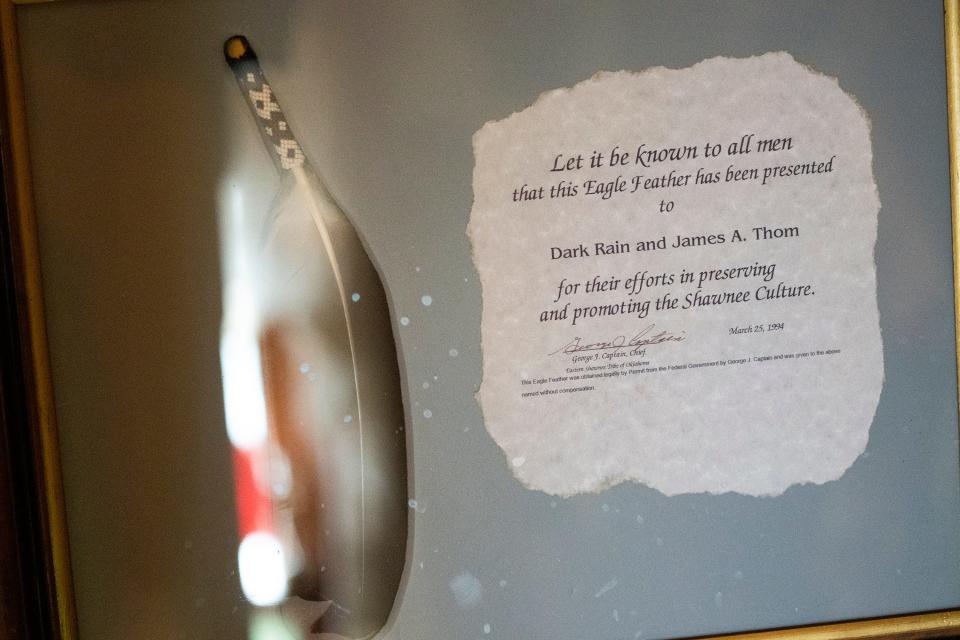
Thom’s home itself has become something of an homage to Native American culture and history. Along with the eagle feather, her cabin is filled with what she said are Native American heirlooms; her closet is packed with ceremonial skirts, and a living room table is covered in books on the Shawnee.
The items, many of which were gifted to Thom over the years, are a reminder of a philosophy she abided by as a member of the United Remnant Band of Shawnee: to support one another and welcome each other in.
Instead of fighting over resources and identity, she wishes today’s tribes were more focused on bringing people into their circles to “help them relearn what (they) should have been taught long ago,” she said.
“We’re supposed to be caring about each other, helping each other if we can."
mfilby@dispatch.com
@MaxFilby
dking@dispatch.com
@DanaeKing
Get more political analysis by listening to the Ohio Politics Explained podcast
This article originally appeared on The Columbus Dispatch: Is Ohio home to any Native American tribes? The answer is complicated

